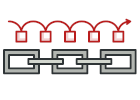
Go 责任链模式讲解和代码示例
责任链是一种行为设计模式, 允许你将请求沿着处理者链进行发送, 直至其中一个处理者对其进行处理。
该模式允许多个对象来对请求进行处理, 而无需让发送者类与具体接收者类相耦合。 链可在运行时由遵循标准处理者接口的任意处理者动态生成。
概念示例
让我们来看看一个医院应用的责任链模式例子。 医院中会有多个部门, 如:
- 前台
- 医生
- 药房
- 收银
病人来访时, 他们首先都会去前台, 然后是看医生、 取药, 最后结账。 也就是说, 病人需要通过一条部门链, 每个部门都在完成其职能后将病人进一步沿着链条输送。
此模式适用于有多个候选选项处理相同请求的情形, 适用于不希望客户端选择接收者 (因为多个对象都可处理请求) 的情形, 还适用于想将客户端同接收者解耦时。 客户端只需要链中的首个元素即可。
正如示例中的医院, 患者在到达后首先去的就是前台。 然后根据患者的当前状态, 前台会将其指向链上的下一个处理者。
department.go: 处理者接口
package main
type Department interface {
execute(*Patient)
setNext(Department)
}
reception.go: 具体处理者
package main
import "fmt"
type Reception struct {
next Department
}
func (r *Reception) execute(p *Patient) {
if p.registrationDone {
fmt.Println("Patient registration already done")
r.next.execute(p)
return
}
fmt.Println("Reception registering patient")
p.registrationDone = true
r.next.execute(p)
}
func (r *Reception) setNext(next Department) {
r.next = next
}
doctor.go: 具体处理者
package main
import "fmt"
type Doctor struct {
next Department
}
func (d *Doctor) execute(p *Patient) {
if p.doctorCheckUpDone {
fmt.Println("Doctor checkup already done")
d.next.execute(p)
return
}
fmt.Println("Doctor checking patient")
p.doctorCheckUpDone = true
d.next.execute(p)
}
func (d *Doctor) setNext(next Department) {
d.next = next
}
medical.go: 具体处理者
package main
import "fmt"
type Medical struct {
next Department
}
func (m *Medical) execute(p *Patient) {
if p.medicineDone {
fmt.Println("Medicine already given to patient")
m.next.execute(p)
return
}
fmt.Println("Medical giving medicine to patient")
p.medicineDone = true
m.next.execute(p)
}
func (m *Medical) setNext(next Department) {
m.next = next
}
cashier.go: 具体处理者
package main
import "fmt"
type Cashier struct {
next Department
}
func (c *Cashier) execute(p *Patient) {
if p.paymentDone {
fmt.Println("Payment Done")
}
fmt.Println("Cashier getting money from patient patient")
}
func (c *Cashier) setNext(next Department) {
c.next = next
}
patient.go
package main
type Patient struct {
name string
registrationDone bool
doctorCheckUpDone bool
medicineDone bool
paymentDone bool
}
main.go: 客户端代码
package main
func main() {
cashier := &Cashier{}
//Set next for medical department
medical := &Medical{}
medical.setNext(cashier)
//Set next for doctor department
doctor := &Doctor{}
doctor.setNext(medical)
//Set next for reception department
reception := &Reception{}
reception.setNext(doctor)
patient := &Patient{name: "abc"}
//Patient visiting
reception.execute(patient)
}
output.txt: 执行结果
Reception registering patient
Doctor checking patient
Medical giving medicine to patient
Cashier getting money from patient patient
 冬季促销!
冬季促销!
